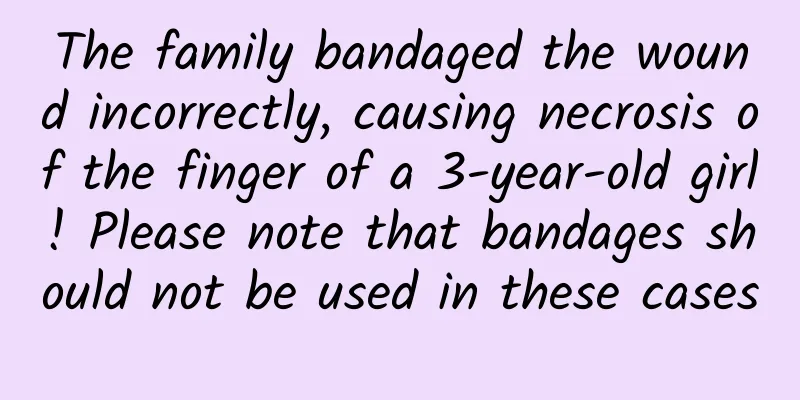The family bandaged the wound incorrectly, causing necrosis of the finger of a 3-year-old girl! Please note that bandages should not be used in these cases

|
Expert in this article: Ao Rongguang, MD, associate chief physician of orthopedics at Shanghai Pudong Hospital, and head of the key subspecialty of osteoporotic fractures in Pudong New Area I saw a heartbreaking hot search a few days ago. A 3-year-old girl injured her finger, but because the wound was not bandaged properly, the finger became deprived of blood and turned black, and eventually had to be amputated. It is inevitable for people to get sick or injured when they eat grains. It is normal to have a minor illness or injury, but if you lack some first aid knowledge, it may even lead to a disaster. For example, do you know when a band-aid should not be used? Let's highlight it. What's wrong with the bandaging in the video? The blackened finger of the child in the video was originally just a common finger injury with bleeding. Due to the family's lack of medical knowledge, they used the wrong bandaging method and eventually had to accept the tragic outcome of finger amputation. The reason is that the Band-Aid was wrapped too tightly around the finger, compressing the finger arteries and nerves, eventually causing ischemic necrosis of the distal finger. Therefore, bandaging wounds is by no means a trivial matter. In most cases, it still requires professional medical staff to perform formal operations. How to bandage correctly? Some people may think that bandaging a wound is simple, and that all they need to do is cover the wound with a piece of gauze or even a napkin. In fact, this is wrong. 1. After medical staff have treated open wounds on the limbs, they will bandage the wounds. Be sure to use sterile gauze to effectively prevent wound infection. 2. At the same time, use tape or a bandage to fix the gauze. The tightness should be appropriate. If it is too loose, the gauze will fall off easily. If it is too tight, it will easily compress the blood vessels and nerves. Taking common hand injuries as an example, if the wound is located on the middle or proximal segment of the palm or finger, the distal segment of the finger must be exposed when bandaging with gauze to observe the blood supply and sensory changes at the distal end. This demonstration shows how to bandage a wound on the middle section of a finger. Note that the end of the finger should be exposed (Source: Photo provided by the author) This demonstration shows how to bandage a wound at the end of a finger (Source: Photo provided by the author) These two pictures only demonstrate the key points of bandaging. In routine operation, the wound needs to be disinfected first and then bandaged with sterile gauze. In what situations should you not use a Band-Aid? Band-aids are emergency items that are often used by everyone. They can protect the wound surface and stop bleeding quickly, but you must remember that band-aids are not omnipotent! They should be used reasonably according to the type of wound. If the wound is small and shallow, such as a finger scratched by a clean knife, and the wound is small and does not require suture, a Band-Aid can be used after cleaning the wound. However, if the wound is deep, large, or contains foreign matter, do not use a Band-Aid. You need to go to the hospital for treatment. For epidermal abrasions, it is recommended to disinfect the wound, expose the abrasion, and do not use a band-aid on the outside; if it is an infected wound, it is also prohibited to use a band-aid. For skin abrasions, blindly using band-aids will not be conducive to wound recovery due to their non-breathable nature. For deeper or infected wounds, blindly using band-aids may cause or aggravate infection. When using a bandage, we should pay attention to the following points: 1. Band-aids are not breathable. The moisture and sweat secreted by the skin around the wound cannot penetrate the band-aids, which will soak the local skin and hinder wound healing. Therefore, it is best to change them every day. 2. When changing the bandage, pay attention to the wound. If the wound is red, swollen, or has exudation, it means that the wound may be infected and you need to go to the hospital for further treatment. 3. When using a Band-Aid, avoid wrapping the wound too tightly. How should different wounds be treated? Different open wounds require different treatments. Superficial abrasions, such as the most common skin abrasions in front of the knee 1) First rinse the wound with saline to remove foreign matter in the epidermis; 2) Use iodine cotton balls to disinfect the wound. You can also apply red medicine to the wound and keep it dry. Generally, there is no need to bandage the wound. If redness, swelling or exudation occurs around the wound, you need to go to the hospital for further diagnosis and treatment. Small, shallow wounds 1) The disinfection method is the same as that for epidermal abrasions; 2) After disinfection, you can bandage the wound with gauze or a band-aid. Pay attention to whether the wound is bleeding and change the gauze or band-aid regularly. 3) If the wound is long, even if not deep, it is recommended to go to the hospital for treatment. A professional doctor will be required to determine whether debridement and suturing are required. Deep wounds Regardless of the size of the wound, further diagnosis and treatment are required in the hospital. Because when the wound is deep, it may damage the tendons, affect the movement of the limbs, and even damage the nerves, causing sensory and motor disorders. In this case, emergency treatment is also very important. 1) It is best to use sterile or relatively clean items to press the bleeding point and perform a preliminary bandage on the wound; 2) Raise the affected limb as much as possible to reduce bleeding from the wound, and never apply any type of medicine on the wound; 3) Go to the hospital as soon as possible. After the professional doctor’s diagnosis, the damaged tissues will be repaired one by one according to the severity of the injury, and finally the wound will be cleaned and sutured. 4) Patients are also required to go to the outpatient clinic of the relevant department for regular follow-up, mainly to observe whether the wound is red and swollen, whether there is exudation, and to change the dressing of the wound. The dressing change needs to be performed under sterile operation, so patients are advised not to change the wound by themselves to avoid improper operation, which may easily cause wound infection. Open wounds that have not been treated for more than 8 hours This situation is prone to infection, and patients are not recommended to bandage the wound by themselves. Instead, they are advised to go to the hospital for treatment and have a professional doctor assess the condition of the wound, clean and bandage the wound, and consider secondary suture after the wound is dry. |
<<: Can pregnant women eat clams? Are there any precautions for pregnant women to eat clams?
Recommend
How long will it take to give birth if the contractions are every ten minutes?
Uterine contraction, simply known as uterine cont...
Can I eat snow lotus during menstruation?
Many people are familiar with snow lotus. Snow lo...
Areola becomes larger after pregnancy
Pregnancy is an exciting thing for female friends...
Menstrual cycle of 21 days makes you age faster
Normally, a woman's menstrual cycle is about ...
What causes women's back pain?
Low back pain is a common condition for many peop...
Endometrial thickness changes
With the improvement of women's status, more ...
It’s the dog days of summer! Have you not saved this summer survival guide yet?
Did you know that summer is not just about waterm...
What should children with Tourette syndrome pay attention to in their diet?
Tic disorder, commonly known as "tics",...
Will the episiotomy split again after the stitches are removed?
Nowadays, women who choose to give birth naturall...
What functions does an air fryer have? How to clean an air fryer?
An air fryer is actually a simple oven with a fan....
How to store strawberries so they don't spoil easily? How to wash strawberries cleanly
Fresh strawberries are a favorite of many people ...
Can I drink baby formula during my period?
Menstruation is a very special day for every woma...
Can I breastfeed after medical abortion during lactation?
Unexpected pregnancy is also possible during brea...









